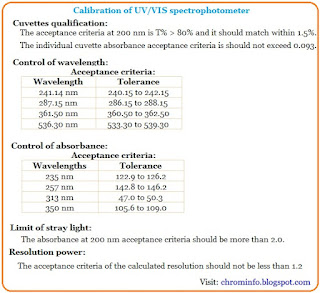Learn the calibration process of the UV/VIS spectrophotometer which includes control of wavelengths using holmium oxide, resolution power using toluene in hexane, control of absorbance using potassium dichromate solution, and limit of stray light using potassium chloride solution.
UV-Vis (Ultraviolet-visible) spectrophotometry is a technique for measuring light absorption in the ultraviolet and visible wavelength range of the electromagnetic spectrum. Incident light can be absorbed, transmitted, or reflected as it strikes matters. Atomic excitation is caused by the absorption of UV-Vis light, which refers to the transition of molecules from a low-energy ground state to an excited state.
| Table of Contents: |
Purpose of the calibration of UV/VIS spectrophotometer:
The purpose of the calibration is to ensure the performance, result accuracy and to establish the reliability of the spectrometer. It is used in the qualitative and quantitative analysis of analytes based on beers lamberts law, hence we frequently need to check the performance of the instruments either internally or by a service engineer.
UV calibration is one of the basic requirements that ensure compliance with the standard as per the Indian Pharmacopeia (IP) and British Pharmacopoeia (BP). Instrument qualification test parameter consists of control of wavelength, control of absorbance, the limit of stray light, and resolution power.
Control of wavelength: It is a process by which accuracy is determined by scanning a known solution for maxima lambda.
Control of absorbance: It is a process by which accuracy is determined by manually scanning a chromophoric solution and recording the absorbance.
Limit of stray light: Stray light is electromagnetic radiation that is not necessary for spectrophotometer analysis and only interferes with the process.
Resolution power: It is the ability to resolve spectral characteristics and bands into their separate components.
Preparation of solvents required for calibration:
Preparation of perchloric acid solution (1.4 M):
Take 11.50 ml of AR grade perchloric acid (70%) using a pipette, dilute up to 100 ml of distilled water in a clean and dry volumetric flask, and properly mixing it.
Preparation of Holmium oxide solution (4% w/v):
Take 01.00 gm of AR grade Holmium oxide and dissolve in 1.4 M perchloric acid solution with the aid of heating. Once it has completely dissolved, make up the volume to 25 ml.
Preparation of sulfuric acid solution (0.005 M):
Take 0.6 ml of sulfuric acid (H2SO4) using a pipette, dilute 2000 ml of distilled water in a volumetric flask, and properly mixing it.
Preparation of potassium dichromate solution:
Take 57 to 63 mg of AR grade previously dried potassium dichromate (K2Cr2O7) and dissolve in 1000 ml of 0.005 M sulfuric acid.
Preparation of potassium chloride (1.2 % w/v):
Take 01.20 gm of previously dried potassium chloride and dissolve in 50 ml of distilled water. Once it has completely dissolved, make up the volume to 100 ml with distilled water.
Preparation of toluene solution in hexane (0.02%):
Take 01.00 ml of HPLC grade toluene using a pipette, dilute in 50 ml of HPLC grade hexane in a volumetric flask, and properly mixing it. Take 0.5 ml of this solution and again dilute to 50 ml with hexane.
Calibration Procedure:
The following are calibration parameters of UV visible spectrophotometer and their stringent limits are adopted from IP, USP, and BP pharmacopeia for acceptance criteria. For instrument operation, follow the standard operating procedure (SOP) and operating laboratory guidelines.
Cuvettes qualification:
Take the transmittance of the cleaned and blank cuvette at 200 nm. The acceptance criteria at 200 nm are T% > 80% and it should match within 1.5%.
Fill the cuvette with Millipore water take the absorbance at 240 nm note down the reading. The individual cuvette absorbance acceptance criteria is should not exceed 0.093.
Control of wavelength:
Take the UV spectrum of Holmium oxide filter or prepared 4%w/v Holmium oxide solution in the range of 200 nm to 600 nm using 1.4 M perchloric acid as a blank.
Acceptance criteria:
|
Wavelength |
Tolerance |
|
241.14 nm |
240.15 to 242.15 |
|
287.15 nm |
286.15 to 288.15 |
|
361.50 nm |
360.50 to 362.50 |
|
536.30 nm |
533.30 to 539.30 |
Control of absorbance:
Take the absorbance of the 1.2 % potassium dichromate at the wavelength given below, and calculate the value of A (1% 1cm) for each wavelength. A (1% 1cm) = absorbance x 1000 / weight of K2Cr2O7.
Acceptance criteria:
|
Wavelengths |
Tolerance |
|
235 nm |
122.9 to 126.2 |
|
257 nm |
142.8 to 146.2 |
|
313 nm |
47.0 to 50.3 |
|
350 nm |
105.6 to 109.0 |
Limit of stray light:
Using water as a blank, measure the absorbance of the prepared 1.2 % potassium chloride solution using a path length of 1 cm at 200 nm. The absorbance at 200 nm acceptance criteria should be more than 2.0.
Resolution power:
Take the UV-spectrum of prepared 0.02% v/v toluene solution in the range of 250 nm to 300 nm using hexane as a blank. Record the absorbance at 269 nm for the maxima and 266 nm for the minima. The acceptance criteria of the calculated resolution should not be less than 1.2.
You may also like this

No comments:
Post a Comment